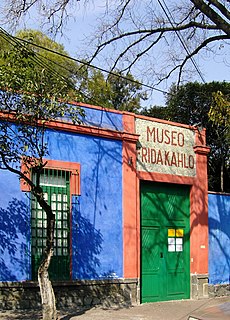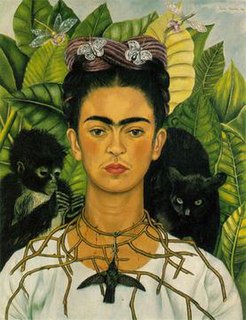
Magdalena Carmen Frida Kahlo y Calderón was a Mexican painter known for her many portraits, self-portraits, and works inspired by the nature and artifacts of Mexico. Inspired by the country's popular culture, she employed a naïve folk art style to explore questions of identity, postcolonialism, gender, class, and race in Mexican society. Her paintings often had strong autobiographical elements and mixed realism with fantasy. In addition to belonging to the post-revolutionary Mexicayotl movement, which sought to define a Mexican identity, Kahlo has been described as a surrealist or magical realist. She is known for painting about her experience of chronic pain.

Frida is a 2002 American biographical drama film directed by Julie Taymor which depicts the professional and private life of the surrealist Mexican artist Frida Kahlo.

Lola Álvarez Bravo was the first Mexican female photographer and a key figure in the post-revolution Mexican renaissance. Known for her high level of skill in composition, her works were seen by her peers as fine art. She was recognized in 1964 with the Premio José Clemente Orozco, by the State of Jalisco, for her contributions to photography and her efforts to preserve the culture of Mexico. Her works are included in the permanent collections of international museums, including the Museum of Modern Art in New York City.
María Izquierdo was a Mexican painter. She is known for being the first Mexican woman to have her artwork exhibited in the United States. She committed both her life and her career to painting art that displayed her Mexican roots and held her own among famous Mexican male artists: Diego Rivera, José Clemente Orozco, and David Alfaro Siqueiros.
Latin American art is the combined artistic expression of South America, Central America, the Caribbean, and Mexico, as well as Latin Americans living in other regions.

Dorothy Hale was an American socialite and aspiring actress. She died after jumping off a building in New York City. Her husband's death, followed by several unsuccessful relationships, left her financially dependent on her wealthy friends. The artist Frida Kahlo created a famous painting based on her death, titled The Suicide of Dorothy Hale.
Fanny Rabel, born Fanny Rabinovich, was a Polish-born Mexican artist who is considered to be the first modern female muralist and one of the youngest associated with the Mexican muralism of the early to mid 20th century. She and her family arrived to Mexico in 1938 from Europe and she studied art at the Escuela Nacional de Pintura, Escultura y Grabado "La Esmeralda", where she met and became friends with Frida Kahlo. She became the only female member of “Los Fridos” a group of students under Kahlo’s tutelage. She also worked as an assistant and apprentice to Diego Rivera and David Alfaro Siqueiros, painting a number of murals of her own during her career. The most significant of these is "Ronda en el tiempo" at the Museo Nacional de Antropología in Mexico City. She also created canvases and other works, with children often featured in her work, and was one of the first of her generation to work with ecological themes in a series of works begun in 1979.
Paula Santiago is a Mexican mixed media artist whose works have been displayed at the Monterrey Museum of Modern Art and several galleries in Europe and North America. Most of her work stands out by being made with her own blood and hair.

The Museo Dolores Olmedo is an art museum in the capital of Mexico, based on the collection of the Mexican businesswoman Dolores Olmedo.

Manuel Mendive Hoyos is one of the leading Afro-Cuban artists to emerge from the revolutionary period, and is considered by many to be the most important Cuban artist living today.

Gerardo Mosquera is a freelance curator, critic, art historian, and writer based in Havana, Cuba. He was one of the organizers of the first Havana Biennial in 1984 and remained central to the curatorial team until he resigned in 1989. Since then, his activity turned to be mainly international: he has been traveling, lecturing and curating exhibitions in more than 80 countries. Mosquera was adjunct curator at the New Museum of Contemporary Art, New York, from 1995 to 2009. Since 1995 he is advisor in the Rijksakademie van Beeldende Kusten in Amsterdam. His publications include several books on art and art theory, and more than 600 articles, reviews and essays have appeared in numerous magazines, including: Art Nexus, Cahiers, Lápiz, Neue Bildende Kunst, Oxford Art Journal, Poliester, Third Text. Among other volumes, Mosquera has edited Beyond the Fantastic: Contemporary Art Criticism from Latin America and co-edited Over Here: International Perspectives on Art and Culture. His theoretical essays – which have been influential in discussing art’s cultural dynamics in an internationalized world, and contemporary Latin American art – are dispersed in English, but have been collected in books in Caracas and Madrid in Spanish, and in Chinese in Beijing. Mosquera was the Artistic Director of PHotoEspaña, Madrid (2011–2013), the Chief Curator of the 4th Poly/Graphic San Juan Triennial (2015-2016), and co-curator of the 3rd Documents, Beijing (2016).

The Frida Kahlo Museum, also known as the Blue House for the structure's cobalt-blue walls, is a historic house museum and art museum dedicated to the life and work of Mexican artist Frida Kahlo. It is located in the Colonia del Carmen neighborhood of Coyoacán in Mexico City. The building was Kahlo's birthplace, the home where she grew up, lived with her husband Diego Rivera for a number of years, and where she later died in a room on the upper floor. In 1957, Diego Rivera donated the home and its contents in order to turn it into a museum in Frida's honor.
Frida Still Life is a 1983 Mexican drama film directed by Paul Leduc. The film was selected as the Mexican entry for the Best Foreign Language Film at the 58th Academy Awards, but was not accepted as a nominee.

The Two Fridas is an oil painting by Mexican artist Frida Kahlo. The painting was the first large-scale work done by Kahlo and is considered one of her most notable paintings. It is a double self-portrait, depicting two versions of Kahlo seated together. One is wearing a white European-style Victorian dress while the other is wearing a traditional Tehuana dress. The painting is housed at the Museo de Arte Moderno in Mexico City.

The Wounded Table is an oil painting by Mexican artist Frida Kahlo. Although lost in 1955, three photos of this painting were taken between 1940 and 1944. The painting was first displayed in January 1940 at the International Surrealism Exhibit at Inés Amor's Gallery of Mexican Art in Mexico City, and a replica is currently displayed in the Kunstmuseum Gehrke-Remund, Baden-Baden, Germany. The painting was last exhibited in Warsaw in 1955, after which it disappeared, and is the subject of an ongoing international search.

Self-Portrait with Thorn Necklace and Hummingbird is a 1940 painting by Mexican painter Frida Kahlo.
Carla Stellweg, born in the Dutch East Indies where she lived as well as in the Netherlands, Mexico and New York. Stellweg began her career in 1965 working as an assistant curator to Fernando Gamboa, the renowned museum builder who organized a plethora of international exhibitions on Mexico, its art and culture around the world. Stellweg is an art historian, curator, and writer with a specialization on Latin American and Latino-US art and artists. She served as Deputy Director of the Rufino Tamayo Museum at its opening and prior to the Tamayo Museum, she co-founded, edited and directed the first bilingual (Spanish-English) arts magazine in Latin America from 1973-1981.

The Wounded Deer is an oil painting by Mexican artist Frida Kahlo created in 1946. It is also known as The Little Deer. Through The Wounded Deer, Kahlo shares her enduring physical and emotional suffering with her audience, as she did throughout her creative oeuvre. This painting in particular was created towards the end of Kahlo's life, when her health was in decline. Kahlo combines pre-Columbian, Buddhist, and Christian symbols to express her wide spectrum of influences and beliefs.
Celia Álvarez Muñoz is a Chicana mixed-media conceptual artist and photographer based in Arlington, Texas.
Frances Borzello is a British art historian and scholar, feminist art critic and author. Her work specializes in the social history of art, and includes study on the social position of European woman artists in the context of their society, the study of female self-portraits and female nudes. She authored the book Seeing Ourselves: Women's Self Portraits, which has been continuously published since 1998 and has 30 editions. Her work widely recognized as contribution to the fields of art history and women's studies.










